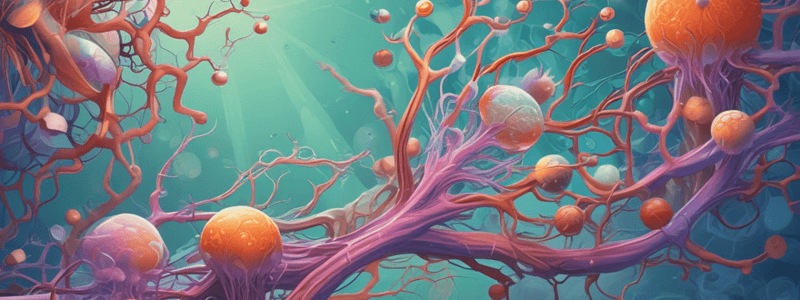Podcast
Questions and Answers
Botany is the study of animals.
Botany is the study of animals.
False (B)
The nucleus contains the genetic material of a cell.
The nucleus contains the genetic material of a cell.
True (A)
Photosynthesis is the process of breaking down glucose to produce energy.
Photosynthesis is the process of breaking down glucose to produce energy.
False (B)
The genetic code is the sequence of nucleotides in DNA that determines traits.
The genetic code is the sequence of nucleotides in DNA that determines traits.
Mutation is a mechanism of genetic inheritance.
Mutation is a mechanism of genetic inheritance.
The fossil record is evidence for evolution.
The fossil record is evidence for evolution.
Producers obtain energy by consuming other organisms.
Producers obtain energy by consuming other organisms.
Limiting factors affect the growth rate of a population.
Limiting factors affect the growth rate of a population.
Flashcards are hidden until you start studying
Study Notes
Branches of Biology
- Botany: study of plants
- Zoology: study of animals
- Microbiology: study of microorganisms (bacteria, viruses, etc.)
- Ecology: study of interactions between organisms and their environment
Cell Biology
- Cell: basic unit of life, consists of:
- Plasma membrane: outer layer, regulates what enters/leaves cell
- Cytoplasm: jelly-like substance inside cell, site of metabolic reactions
- Nucleus: contains genetic material (DNA)
- Mitochondria: site of cellular respiration (energy production)
- Cellular processes:
- Photosynthesis: conversion of light energy to chemical energy
- Cellular respiration: breakdown of glucose to produce energy
Genetics
- Heredity: passing of traits from parents to offspring
- Genetic code: sequence of nucleotides (A, C, G, T) in DNA that determines traits
- Inheritance patterns:
- Dominant/recessive traits
- Autosomal dominant/recessive traits
- X-linked traits
Evolution
- Theory of evolution: gradual change in species over time through natural selection
- Mechanisms of evolution:
- Mutation: change in DNA sequence
- Genetic drift: random change in gene pool
- Gene flow: movement of genes between populations
- Evidence for evolution:
- Fossil record
- Comparative anatomy
- Molecular biology
Ecology
- Ecosystem: community of organisms and their environment
- Energy flow:
- Producers (plants): convert sunlight to energy
- Consumers (herbivores, carnivores, omnivores): obtain energy by consuming other organisms
- Decomposers (bacteria, fungi): break down organic matter
- Population dynamics:
- Growth rates
- Limiting factors (resources, predators, disease)
Branches of Biology
- Botany is the study of plants
- Zoology is the study of animals
- Microbiology is the study of microorganisms such as bacteria and viruses
- Ecology is the study of interactions between organisms and their environment
Cell Biology
- The cell is the basic unit of life
- Plasma membrane regulates what enters and leaves the cell
- Cytoplasm is a jelly-like substance inside the cell where metabolic reactions occur
- The nucleus contains genetic material in the form of DNA
- Mitochondria are the site of cellular respiration where energy is produced
- Photosynthesis is the conversion of light energy to chemical energy
- Cellular respiration is the breakdown of glucose to produce energy
Genetics
- Heredity is the passing of traits from parents to offspring
- The genetic code is a sequence of nucleotides (A, C, G, T) in DNA that determines traits
- Dominant and recessive traits are determined by the genetic code
- Autosomal dominant and recessive traits are related to genes on non-sex chromosomes
- X-linked traits are related to genes on the X chromosome
- Inheritance patterns can be predicted using the genetic code
Evolution
- The theory of evolution states that species change over time through natural selection
- Mutation is a change in the DNA sequence
- Genetic drift is a random change in the gene pool
- Gene flow is the movement of genes between populations
- The fossil record, comparative anatomy, and molecular biology provide evidence for evolution
- Evolution occurs through the gradual change in species over time
Ecology
- An ecosystem is a community of organisms and their environment
- Producers convert sunlight to energy through photosynthesis
- Consumers obtain energy by consuming other organisms
- Decomposers break down organic matter
- Energy flows from producers to consumers to decomposers
- Population growth rates are affected by limiting factors such as resources, predators, and disease
Studying That Suits You
Use AI to generate personalized quizzes and flashcards to suit your learning preferences.




